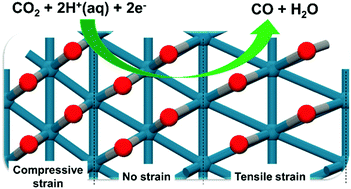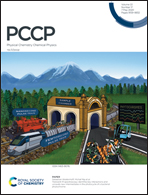Computational insights into the strain effect on the electrocatalytic reduction of CO2 to CO on Pd surfaces†
Abstract
Electrochemical CO2 reduction reaction (CO2RR) provides a promising scenario to achieve carbon renewable energy storage and alleviate energy depletion. It was found experimentally in the literature that strain over Pd surfaces can adjust the activity and selectivity of electrocatalytic CO2RR. Here, using density functional theory (DFT) calculations and the Sabatier analysis method, we investigated the electrochemical reduction of CO2 to CO at different electric potentials over Pd surfaces with lattice strains of −2%, −1%, 1% and 2%. Four types of Pd surfaces with different structures and co-ordination numbers were considered, namely Pd(111), (100), (110) and (211). We obtained the differential adsorption energy of key intermediates in CO2RR, i.e. COOH and CO, with DFT as a function of CO coverage on these Pd surfaces. Further analysis showed that the adsorption energy at high coverage might be correlated with the Coulomb interaction energy between surface species. With the adsorbate–adsorbate interactions included in the analyses, we found that the strained Pd(111) surface shows the highest CO2RR activity among the four surfaces considered, which is consistent with previous experimental observations. These results highlight the significance of surface strain effects on the reactivity of CO2RR and provide guidance for practical catalyst development.

- This article is part of the themed collection: PCCP Emerging Investigators


 Please wait while we load your content...
Please wait while we load your content...